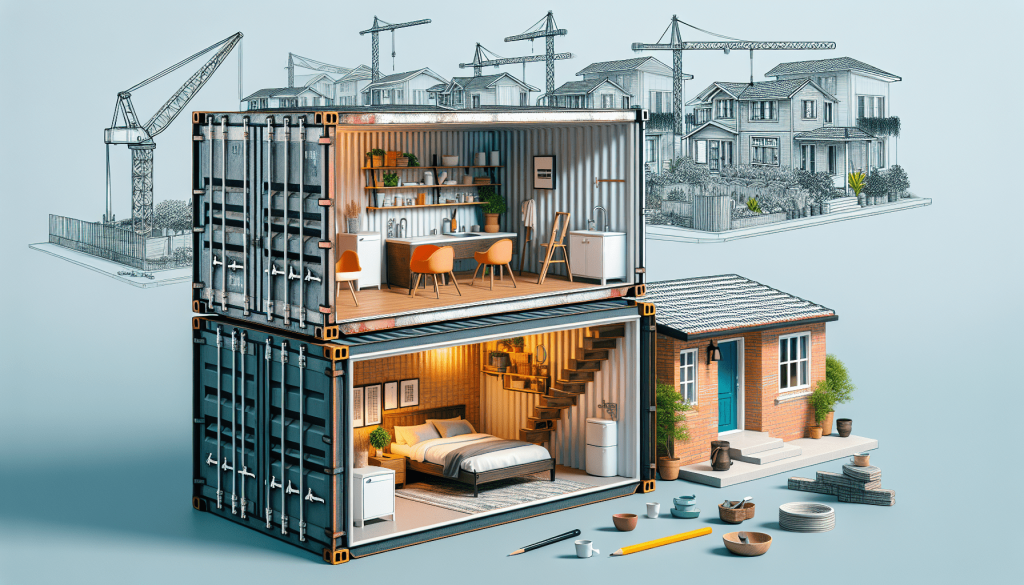Have you ever wondered if building a shipping container home is a cost-effective option? Well, you’re in luck because this article explores whether it is truly cheaper to construct a home using shipping containers. Many people are intrigued by the idea of living in a unique, eco-friendly space, but they also want to ensure it fits within their budget. Join us as we investigate the costs, benefits, and potential drawbacks of building a shipping container home to help you make an informed decision.
Introduction
Welcome! In this article, we will delve into the fascinating world of shipping container homes. You may have heard about this innovative and cost-effective alternative to traditional housing. But what exactly are shipping container homes, and what factors affect their cost? Are they truly more affordable than conventional houses? We will explore these topics and more as we take a closer look at the advantages, challenges, and considerations of shipping container homes.
Understanding Shipping Container Homes
Definition and concept of shipping container homes
Shipping container homes, as the name suggests, are houses constructed using repurposed shipping containers. These containers, typically made of steel, are the structural building blocks that form the framework of the homes. They are versatile, sturdy, and readily available. With the right modifications and design choices, shipping containers can be transformed into functional and comfortable living spaces.
Advantages and disadvantages of shipping container homes
There are several advantages to opting for a shipping container home. First and foremost, they can be significantly less expensive than traditional houses. Shipping containers are often readily available at affordable prices, making them a budget-friendly choice for homeowners. Additionally, these homes are eco-friendly, as they involve recycling and repurposing materials that would otherwise go to waste.
However, it’s crucial to consider the disadvantages as well. One major drawback is the limited space available in shipping containers. While they can be combined and modified to create larger living areas, the overall size is still smaller compared to conventional homes. Additionally, insulation and ventilation can be a challenge in container homes, requiring extra attention and modifications to ensure adequate comfort.

Factors Affecting the Cost
Size and layout of the container home
The size and layout of a shipping container home play a crucial role in determining its cost. Larger homes, constructed using multiple containers, will naturally require more materials and labor, increasing the overall expense. Similarly, if you desire a more complex layout with multiple levels or unique design features, the cost will be higher compared to a simpler design.
Condition and quality of the shipping containers
The state and quality of the shipping containers themselves can impact the cost of your container home. New or one-trip containers, which have only been used once for transporting goods, tend to be in better condition and can be more expensive. On the other hand, used containers may have some wear and tear, but they can save you money if they are in good structural condition.
Site preparation and foundation
Before building your container home, you must prepare the site and establish a solid foundation. Factors like soil conditions, slope, and accessibility can affect the cost of site preparation. If the land requires extensive leveling or excavation, it can significantly increase the overall expense. Additionally, the type of foundation, such as a concrete slab or pier system, will also impact the cost.
Insulation and modification requirements
One of the key considerations when building a container home is proper insulation and modification. Shipping containers are not inherently designed for comfortable living spaces, so insulation is crucial for temperature regulation. Insulating the walls, roof, and floor can add to the cost, but it is necessary for maintaining a comfortable indoor environment. Other modifications, such as windows, doors, and partitions, may also be required and can impact the overall cost.
Plumbing and electrical systems
Integrating plumbing and electrical systems into a container home involves additional costs. Plumbing requires careful planning and installation, including connections to city water and sewer lines or the installation of a septic system. Similarly, electrical systems need to be designed and installed properly to ensure safety and functionality. The complexity of these systems and the level of customization you desire will influence the cost.
Additional features and customization
The cost of your shipping container home can be further influenced by additional features and customization options. If you wish to incorporate solar panels, a rainwater harvesting system, or high-end finishes, the expenses will increase accordingly. Customization, such as unique architectural elements or specific design choices, will also impact the overall cost.
Comparing Costs: Container Home vs. Traditional Home
Initial construction costs
When comparing the initial construction costs, shipping container homes generally come out as the more affordable option. The cost per square foot of a container home is typically lower than that of a traditional home. However, it’s important to consider the specific factors and requirements of your project, as they can greatly influence the overall cost.
Site and foundation costs
While shipping container homes may offer savings in terms of construction, site and foundation costs can still be significant. Proper site preparation, including excavation, leveling, and utility connections, can add to the overall expense. The foundation type chosen, whether it be a concrete slab or a raised pier system, will also impact the cost.
Labor and construction time
Container homes often require less construction time compared to traditional homes. The pre-fabricated nature of shipping containers allows for a quicker assembly process. However, it’s worth noting that skilled labor is still required for tasks such as welding, cutting, insulation installation, and the integration of plumbing and electrical systems. The cost of labor will vary depending on the complexity of the project and the local labor market.
Maintenance and upkeep expenses
One advantage of shipping container homes is their durability. Made of steel, these structures are built to withstand harsh conditions and are resistant to pests and rot. As a result, maintenance and upkeep expenses are generally lower compared to traditional homes. However, it’s still important to regularly inspect and maintain the container home to ensure its longevity.
Resale value and long-term cost analysis
Resale value and long-term cost analysis are important factors to consider when comparing container homes to traditional homes. While container homes may have lower upfront costs, their resale value can vary depending on factors such as location, design, and market demand. Additionally, long-term cost analysis should include considerations such as energy efficiency, ongoing maintenance, and potential modifications or upgrades over time.

Hidden Costs and Challenges
Licensing and building code requirements
When building a shipping container home, it’s essential to understand and comply with local licensing and building code requirements. These requirements can vary significantly from one jurisdiction to another. It’s crucial to consult with professionals and obtain the necessary permits to avoid potential legal issues or costly modifications in the future.
Permits and zoning regulations
In addition to building codes, permits and zoning regulations are also factors that can impact the cost of constructing a container home. Some areas may have restrictions on the use of shipping containers for residential purposes or have specific zoning requirements. It’s important to research and understand these regulations before embarking on your container home project.
Transportation and delivery costs
One often overlooked factor is the transportation and delivery costs associated with shipping containers. Depending on the location of the containers and the distance to your building site, transportation expenses can add up. Additionally, if the site is inaccessible by standard delivery trucks, special equipment or alternative transportation methods may be required, resulting in additional costs.
Site preparation and utilities installation
Preparing the building site and installing utilities can be more complex for container homes compared to traditional homes. Depending on the site conditions, additional work such as clearing vegetation, leveling the ground, or creating suitable access points may be necessary. Installing utilities such as water, electricity, and sewage connections may also require extra effort and expense, particularly in remote or off-grid locations.
Structural integrity and load-bearing considerations
While shipping containers are inherently strong, it’s important to consider structural integrity and load-bearing capabilities when designing a container home. Adding doors, windows, and modifying the container’s structure can affect its overall stability. Seeking professional advice and ensuring proper engineering is crucial to ensure the safety and integrity of the structure.
Ensuring proper insulation and ventilation
As mentioned earlier, insulation and ventilation can be challenging in container homes. Proper insulation is essential for maintaining a comfortable indoor environment, particularly in extreme climates. Ventilation is also crucial to prevent moisture buildup and ensure air quality. Failing to address these aspects properly can lead to issues such as condensation, mold growth, or uncomfortable temperature fluctuations.
Sustainability and Environmental Impact
Advantages of recycling shipping containers
One of the major advantages of shipping container homes is their positive impact on the environment. By repurposing shipping containers, we are recycling resources that would otherwise go to waste. This reduces the demand for new construction materials and helps to minimize the carbon footprint associated with traditional construction methods. By choosing a container home, you are contributing to a more sustainable future.
Energy efficiency and eco-friendly features
Container homes can also be designed with energy efficiency and eco-friendly features in mind. Proper insulation, energy-efficient windows and doors, and smart design choices can help reduce energy consumption. Additionally, integrating renewable energy systems such as solar panels can further enhance the eco-friendliness of container homes.
Reduced carbon footprint
By choosing a container home, you are making a conscious decision to reduce your carbon footprint. By repurposing shipping containers, you contribute to the reduction of carbon emissions associated with the manufacturing of new construction materials. Container homes also have the potential to utilize renewable energy sources, further reducing their environmental impact.
Benefits of repurposing materials
Repurposing materials, such as shipping containers, has several benefits. It reduces waste and lowers the demand for new resources. It also helps to showcase innovative and sustainable architectural solutions. By repurposing shipping containers, we can inspire others to think creatively about how we use materials and promote sustainable practices in the construction industry.
Design and Aesthetic Considerations
Limitations and constraints of container architecture
Container architecture, while innovative and cost-effective, comes with some limitations. The size of shipping containers can impose constraints on the design and layout options. If you desire larger living spaces or specific architectural features, additional containers or modifications may be necessary. Understanding and embracing these constraints is crucial when designing a container home.
Innovative design solutions
Despite the limitations, container homes offer numerous opportunities for innovative design solutions. Architects and designers around the world have created stunning container homes that showcase the versatility and potential of these structures. From multi-level container homes to unique container configurations, creative design solutions can transform shipping containers into beautiful and functional living spaces.
Enhancing the visual appeal of container homes
Container homes can be aesthetically appealing, both from the inside and the outside. Design choices such as exterior cladding, paint colors, and creative landscaping can enhance the visual appeal of your container home. Additionally, the interior design and thoughtful space optimization can create a comfortable and inviting living environment.
Interior design and space optimization
Effective interior design and space optimization are essential for maximizing the functionality and livability of container homes. Clever storage solutions, multi-purpose furniture, and efficient use of vertical space can help create a spacious and comfortable interior. Professionals specializing in container home design can provide valuable insights and guidance in creating a practical and visually appealing living space.
Availability and Accessibility
Availability of shipping containers
Shipping containers are widely available, making them accessible for individuals interested in building container homes. Containers can be purchased from suppliers, shipping companies, or brokers who specialize in container sales. The availability of different sizes and conditions of containers offers flexibility in choosing the right ones for your project.
Shipping container home builders and suppliers
As the interest in container homes grows, so does the number of container home builders and suppliers. Many companies now specialize in designing and constructing container homes, offering a range of services from initial design consultations to turnkey solutions. Working with experienced professionals ensures that your container home meets your specific needs and adheres to local building codes and regulations.
Geographical limitations and logistics
While containers can be shipped almost anywhere, it’s important to consider logistical factors before embarking on a container home project. The availability and cost of shipping containers can vary depending on the region. Additionally, transportation and delivery logistics should be carefully planned, especially if your building site is in a remote or hard-to-reach location.
Popular Applications and Success Stories
Residential container homes
Shipping container homes have gained popularity as unique and affordable housing options. Many individuals and families have successfully transformed containers into comfortable, stylish, and functional residences. From single-container dwellings to multi-unit container complexes, residential container homes offer an alternative to traditional housing that is both cost-effective and environmentally friendly.
Commercial and public space projects
Shipping containers have also been employed in commercial and public space projects to create unique and eye-catching structures. From trendy pop-up shops and cafes to art galleries and community centers, container architecture is a popular choice for its versatility and architectural appeal. These projects showcase the potential of container design in creating functional and visually appealing spaces.
Emergency and disaster relief housing
The modular nature and rapid construction of shipping container homes make them suitable for emergency and disaster relief housing. These structures can be quickly deployed to areas affected by natural disasters or humanitarian crises, providing immediate shelter to those in need. Container-based relief housing has been successfully implemented in various parts of the world, making a significant impact in times of crisis.
Off-grid and remote location dwellings
Shipping container homes are also well-suited for off-grid and remote location dwellings. With proper insulation, solar power integration, and water collection systems, container homes can provide sustainable and self-sufficient living solutions in areas without regular access to utilities. Their portability and modular design make them ideal for those seeking an alternative lifestyle or a getaway retreat in remote locations.
Conclusion
In conclusion, shipping container homes offer an exciting and cost-effective alternative to traditional housing. While they come with their unique set of advantages, challenges, and considerations, container homes have gained popularity for their affordability, sustainability, and versatility. By repurposing shipping containers and embracing innovative design solutions, container homes can provide comfortable and visually appealing living spaces. Whether you are looking for a residential home, commercial project, or off-grid retreat, container homes offer a range of possibilities worth exploring. So, if you’re considering building a home or space that stands out from the crowd, a shipping container home might just be the perfect choice.

I am James, the creator behind SeaBoxInnovations.com. Welcome to our premier online destination dedicated to the world of sea containers. Think Inside the Box is our tagline, and our website is your go-to source for exploring the endless potential of these versatile and adaptable containers. Whether you’re interested in purchasing, customizing, or learning about the latest trends in container architecture and design, we have you covered. Join us as we bridge the gap between traditional uses and cutting-edge applications, promoting sustainability and innovation in design and construction. Get ready to embark on your next big project with SeaBoxInnovations.com.

